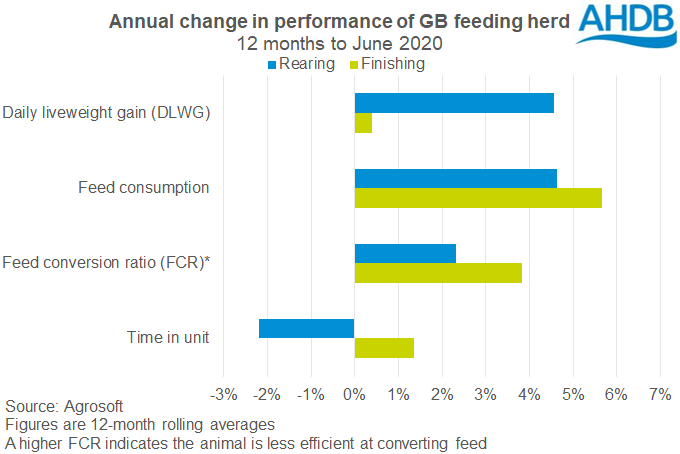Increased feeding compensates for poorer physical performance in feeding herd
Thursday, 24 September 2020
By Felicity Rusk
The latest physical performance data shows an overall poorer performance within the feeding herd in the 12 months to June 2020. Both the rearing and finishing herd were less efficient at converting feed compared to the previous 12 months. However, increased feed consumption was able to compensate for this and was translated into higher daily growth.

Pigs at the rearing stages gained more weight per day in the 12 months ending June 2020, compared to the previous year. The daily liveweight gain (DLWG) for this period averaged 483g, 21g (5%) more than when compared to the previous year. As a result of this, pigs at this stage spent on average one day less within the rearing unit and were on average 690g heavier at the point of transfer.
The improvements in growth rates is likely a reflection feed usage. During the rearing stage, feed consumption averaged 53kg/head, over 2kg (5%) more than during the 12 months ending June 2019. While feed prices are considerably higher than last year (+10%), the prolonged period of elevated finished pig price, and increases in maximum weights in some contracts, may have provided the incentive to producers to increase feed usage. However, with pig prices dropping back in the past couple of weeks, producers may have to re-evaluate their feeding options.
However, while feed usage was up on the year, pigs within the rearing unit were converting feed slightly less efficiency. In the 12 months to June 2020, the feed conversion ratio (FCR) averaged 1.78, 0.04 more when compared to the previous 12 months. This means than an additional 40g of feed was required for every 1kg of weight gained.
Feed consumption for pigs at the finishing stage also increased. In the 12 months ending June 2020, feed consumption averaged 207 kg/pig, over 11kg (+6%) more than in the previous 12 months. Pigs at the finishing stage were also less efficient at converting feed into weight gain. The FCR averaged 2.75, 0.10 lower than the previous 12 months. This means an additional 100g feed was required for each 1kg of weight gain.
The additional feed provision does appear to have compensated for the poorer efficiency as growth rates were marginally higher. In the 12 months ending June 2020, the DLWG averaged 838g/day, 3g more than in the previous 12 months. Despite this marginal improvements in weight gains, pigs spend on average one additional day in the finishing unit.
Sign up for regular updates
Subscribe to receive pork market news straight to your inbox. Simply complete our online form.
While AHDB seeks to ensure that the information contained on this webpage is accurate at the time of publication, no warranty is given in respect of the information and data provided. You are responsible for how you use the information. To the maximum extent permitted by law, AHDB accepts no liability for loss, damage or injury howsoever caused or suffered (including that caused by negligence) directly or indirectly in relation to the information or data provided in this publication.
All intellectual property rights in the information and data on this webpage belong to or are licensed by AHDB. You are authorised to use such information for your internal business purposes only and you must not provide this information to any other third parties, including further publication of the information, or for commercial gain in any way whatsoever without the prior written permission of AHDB for each third party disclosure, publication or commercial arrangement. For more information, please see our Terms of Use and Privacy Notice or contact the Director of Corporate Affairs at info@ahdb.org.uk © Agriculture and Horticulture Development Board. All rights reserved.

